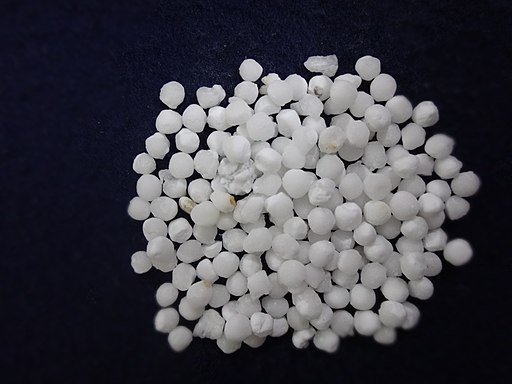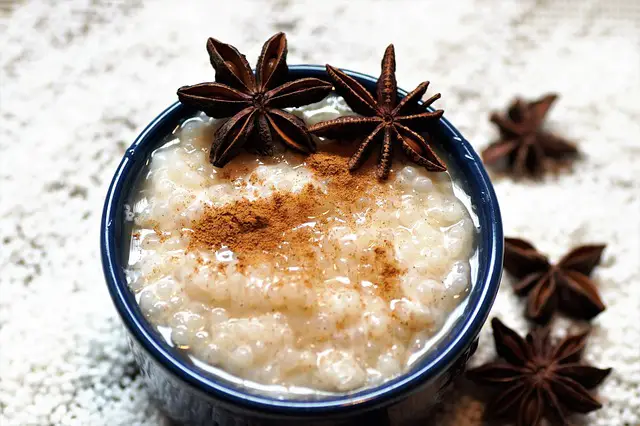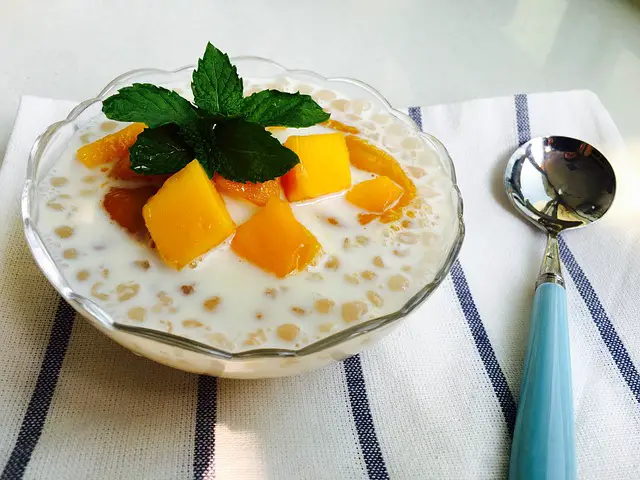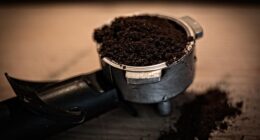Sago is a starch extracted from palm trees, while tapioca is derived from cassava roots. Both used in cooking, but from different plant sources.
TL;DR Sago Vs. Tapioca
Sago is derived from the pith of tropical palm stems, while tapioca is extracted from the cassava root. Sago has a pearl-like appearance and is typically used in desserts and beverages, adding a unique texture to dishes. Tapioca comes in the form of small pearls or flour and is commonly used as a thickening agent in soups, stews, and baked goods.
What is sago?

Sago comes from the pith of the sago palm tree, specifically from the stems or trunks. The process involves extracting and refining this starchy substance to create small pearl-like granules that we commonly associate with sago.
In terms of appearance and texture, sago pearls are almost translucent and have a distinctive chewy consistency when cooked. They can be white or slightly yellowish in color and are prized for their ability to absorb flavors, making them versatile in various culinary preparations.
Sago has been used for centuries as a staple food in many Southeast Asian countries such as Indonesia and Malaysia. It’s often incorporated into desserts like puddings, custards, and sweet soups due to its natural sweetness. However, it can also be utilized in savory dishes such as dumplings or used as a thickening agent in sauces.
What is Tapioca?

Tapioca is a starchy substance that comes from the roots of the cassava plant. It is widely used in cooking and baking due to its versatility and unique texture. The process of making tapioca involves extracting the starch from the cassava root, which is then processed into small spherical pearls or flakes.
These pearls or flakes are often boiled or steamed until they become translucent and have a soft, chewy consistency. Tapioca pearls are commonly used in desserts such as puddings, boba tea, and fruit salads. They can also be used as a thickening agent in soups, sauces, and gravies.
One of the key characteristics of tapioca is its ability to absorb flavors well while maintaining its distinct texture. This makes it an excellent ingredient for both sweet and savory dishes. Tapioca has a neutral taste on its own but adds thickness and body to recipes without altering their flavor profile.
In addition to being gluten-free and grain-free, tapioca is also low in calories and fat compared to other starches like wheat flour or cornstarch. It provides energy through carbohydrates while being relatively low in protein and essential nutrients.
Sago Vs. Tapioca – Key differences
| Characteristic | Sago | Tapioca |
|---|---|---|
| Source | Extracted from the pith of various palm trees | Derived from cassava plant roots |
| Plant Origin | Typically found in Southeast Asia, Australia | Native to South America, now grown worldwide |
| Appearance | Small, pearl-like translucent beads | Larger, opaque pearls or granules |
| Processing Method | Extracted, washed, and dried from palm pith | Extracted, grated, and dried from cassava root |
| Texture | Softer, more delicate texture | Firmer, chewier texture |
| Cooking Uses | Often used in desserts, beverages, and as a thickener | Commonly used in puddings, boba tea, and as a thickening agent |
| Culinary Versatility | Limited to specific regional dishes | More versatile, used in various cuisines |
| Nutritional Value | Mostly carbohydrates, minimal nutrients | Provides some vitamins and minerals |
| Allergen Potential | Generally considered allergen-free | May cause allergies in some individuals |
Sago Vs. Tapioca – Nutritional Value
Sago and tapioca have distinct nutritional profiles due to their different sources and processing methods. Here’s a comparison of their nutritional values per 100 grams:
Sago (per 100 grams)
- Calories: 354 kcal
- Carbohydrates: 87.9 grams
- Dietary Fiber: 0.9 grams
- Sugars: 0 grams
- Protein: 0.2 grams
- Fat: 0.2 grams
- Vitamins and Minerals: Minimal, mainly carbohydrates
Tapioca (per 100 grams)
- Calories: 358 kcal
- Carbohydrates: 88.7 grams
- Dietary Fiber: 1.4 grams
- Sugars: 0.2 grams
- Protein: 0.2 grams
- Fat: 0.2 grams
- Vitamins and Minerals: Limited, mainly carbohydrates
Both sago and tapioca are primarily composed of carbohydrates and provide minimal protein and fat. Tapioca contains slightly more dietary fiber than sago, but the difference is relatively small. Neither sago nor tapioca is a significant source of vitamins and minerals.
Both are often used for their starchy qualities and are not typically consumed for their nutritional content. It’s important to note that the nutritional value of dishes or recipes made with sago or tapioca can vary widely depending on other ingredients and preparation methods.
Sago Vs. Tapioca – Health Benefits
Sago and tapioca are primarily sources of carbohydrates and are not known for providing significant health benefits on their own. However, they can be part of a balanced diet and offer some advantages:
Sago
- Energy Source: Sago is a rich source of carbohydrates, making it an energy-dense food. It can provide a quick source of energy when needed.
- Easy Digestion: Sago is easily digestible, which can be helpful for individuals with digestive issues or those recovering from illness.
Tapioca
- Gluten-Free: Tapioca is naturally gluten-free, making it a suitable choice for people with gluten sensitivities or celiac disease.
- Resistant Starch: Some forms of tapioca contain resistant starch, which can have a positive impact on gut health by promoting the growth of beneficial gut bacteria.
- Binding and Thickening Agent: Tapioca starch or flour is commonly used as a thickening agent in cooking and baking, which can be useful for people with dietary restrictions or food sensitivities.
While sago and tapioca have their advantages, they are typically consumed in dishes and recipes that can vary widely in terms of healthiness. For example, both can be used in sugary desserts and beverages that may not be nutritionally balanced.
For a balanced and healthy diet, it’s essential to consume a variety of foods that provide essential nutrients, including fruits, vegetables, lean proteins, and whole grains. While sago and tapioca can be part of a diet, they should be enjoyed in moderation as part of a diverse and well-rounded meal plan.
Popular Dishes and Recipes Using Sago and Tapioca
Sago
- Sago Pudding: A sweet dessert made with sago pearls, milk, sugar, and flavorings like vanilla or rosewater. Sago pudding is popular in many Southeast Asian countries.
- Sago Soup: A soothing and simple soup made with sago pearls, usually cooked in a clear or coconut milk-based broth with vegetables or meat.
- Sago Gulaman: A Filipino beverage made with sago pearls and gulaman (gelatin) cubes soaked in a sweet syrup, often flavored with brown sugar and pandan leaves.
- Sago Fritters: Sago pearls can be mixed with mashed potatoes or other ingredients to make fritters, which are then deep-fried for a crispy snack.
- Sago and Fruit Salad: Sago pearls are combined with a variety of fruits, coconut milk, and condensed milk to create a sweet and refreshing salad.
Tapioca
- Tapioca Pudding: A creamy dessert made with tapioca pearls, milk, sugar, and often flavored with vanilla or spices. It’s a classic comfort food in many Western countries.
- Tapioca Pearl Tea (Boba Tea): Tapioca pearls are added to sweet tea or milk-based drinks to create a chewy and refreshing beverage, popular in Asian and Western countries.
- Tapioca Flour in Baking: Tapioca flour (also called tapioca starch) is used as a gluten-free thickening agent in various recipes, including pies, sauces, and soups.
- Tapioca Crepes: Tapioca flour is used to make Brazilian crepes known as “beiju” or “tapioca,” filled with a variety of sweet or savory fillings.
- Cassava Cake: A Filipino dessert made from grated cassava (the source of tapioca) mixed with coconut milk, sugar, and condensed milk, then baked until golden brown.
Image Credits
Featured Image By – zhaona1206 from Pixabay
Image 1 By – Gausanchennai, CC BY-SA 4.0, via Wikimedia Commons









